|
John Pouncy (1818 -1894)
Although beginning his working life as a house decorator, John Pouncy became a pioneer in the development of photography, a creative but somewhat immodest genius who had to contend with rivalry over the inventor-ship of the process he was convinced he could rightly lay claim to. He also had a sympathetic and philanthropic side to his character that was once put to good use when he lent nursing assistance at the local hospital during an epidemic of cholera.(1) John Pouncy’s was a fascinating and innovative nature, at first somewhat restrained in the full potential of its expression by his first mundane occupation, but the course of his life was first to take a drastic turn.
Pouncy was born in Dorchester on July 16th 1818(2) , the son of William Pouncy, a Piddletrenthide labourer and his wife Mary. In 1843 he married Mary Ann Sprackley(3) , the mother of his first child Walter(4) , though she died in 1846(5) . Just four years later Pouncy met and married Mary Catherine Mills(6) , who presented him with another son and four daughters who all apparently died young or before reaching adulthood (7) .
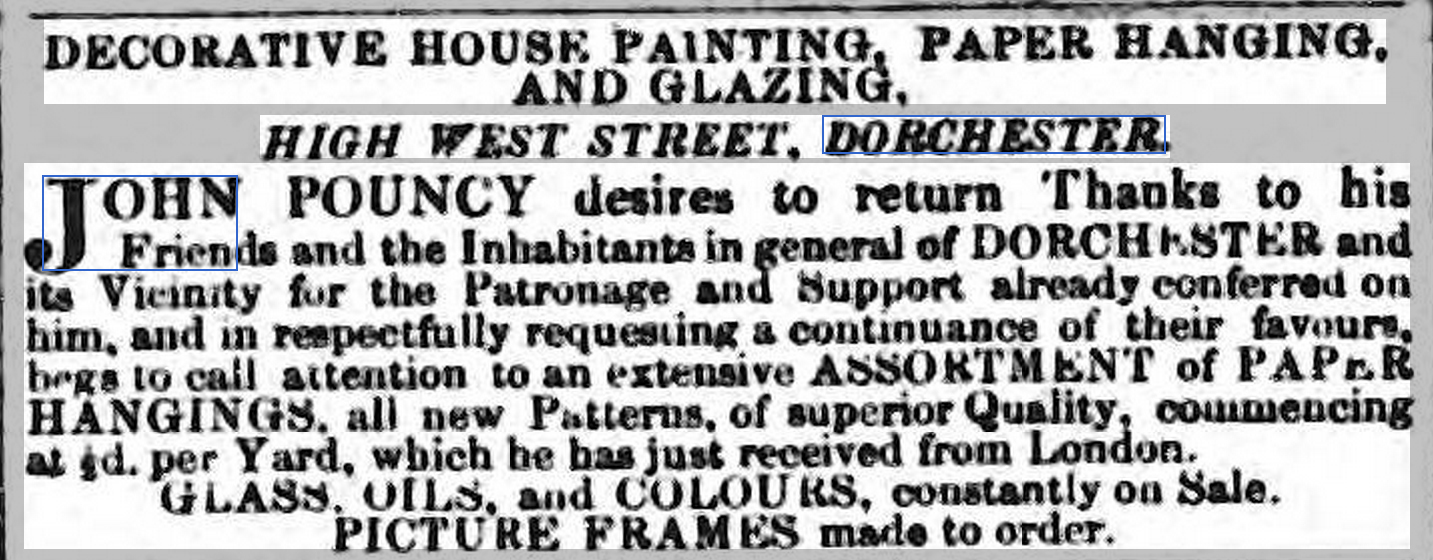
Advert in Dorset County Chronicle for Thursday April 20th 1848
Until 1854 Pouncy was painting and decorating houses, glazing windows, gilding and carving, but then the new science of photography so gripped his imagination that he resolved to dedicate the rest of his life to it. From then on, and for the next four years, he had to support his new occupation with the earnings from his first one. As late as 1859 the Dorset County Chronicle carried a report “…Mr Pouncy’s proper profession is that of a house painter.” Three years earlier Pouncy announced through the Chronicle that he intended to publish a photo-illustrated gazetteer of Dorset featuring pictures captioned with historic commentaries.
But John Pouncy had another aim: to resolve through experimentation a major drawback of early photography: that of fading. At the time photographic prints were produced by the salts of silver process, an emulsion notoriously susceptible to fading, and which would hinder Pouncy’s intention to produce permanent visual records of Dorset. To circumvent the shortcoming, Pouncy resorted to photo-lithography, itself a still very imperfect process. Yet Pouncy’s attempt to unite lithography with photography met with some success with the publication in 1857 of his book “Dorsetshire Photographically Illustrated” – the first English publication ever to feature photo litho-graphic illustrations.
Dorset Photographically Illustrated is a remarkable achievement for the time. It is original in technique and so not at all what would be expected from one who semi-abandoned the painting and decorating trade for a discipline in which he had no prior training. The book features 80 illustrations, each with two or more pages of historical narrative and 200 double-panel 8” x 11” pages. The text is peppered with erudite classical quotations from nature poets such as Cowper, Thomson and Wordsworth, and the writing is that of one trying to impress the reader with his learning. What comes across is the mind of an intelligent, practical autodidact who clearly shows an overriding preoccupation with landscapes. Indeed, Pouncy was only concerned with photography for professional reasons; he nurtured no desire to undertake commissioned work for illustrating the publications of others.
Despite the success of the book Pouncy was sufficiently dissatisfied with the quality of the prints to attempt further improvement through experimentation. Spurred on by the offer of an award from the Photographic Society of London to anyone who could solve the problem of fading. Pouncy worked on a process, the basic principle of which had been discovered by Mungo Ponton in 1839. Ponton had noticed that paper coated with potassium bichromate became photo-reactive. Pouncy then coated paper with bichromate, but added gum Arabic and vegetable carbon to it. Having reported his results to the Photographic society in 1858, Pouncy then patented his process.
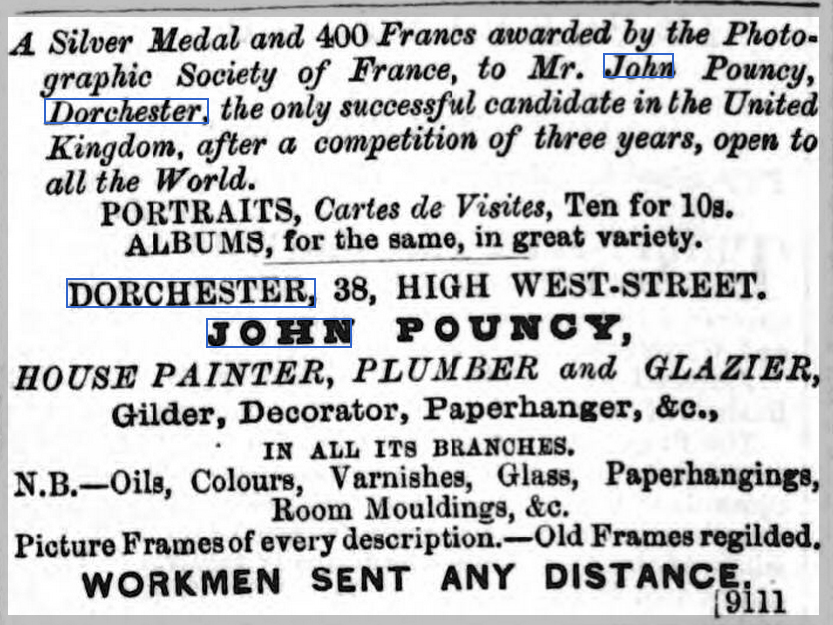 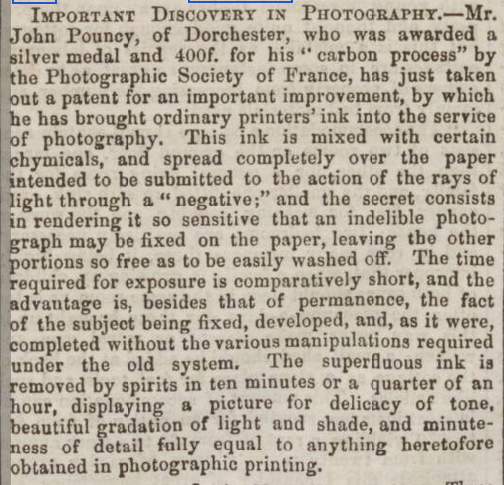
Advert in Somerset Gazette for Thursday October 9th 1862 - and - A Report of his discovery in the Bucks Herald Feb 28th 1863
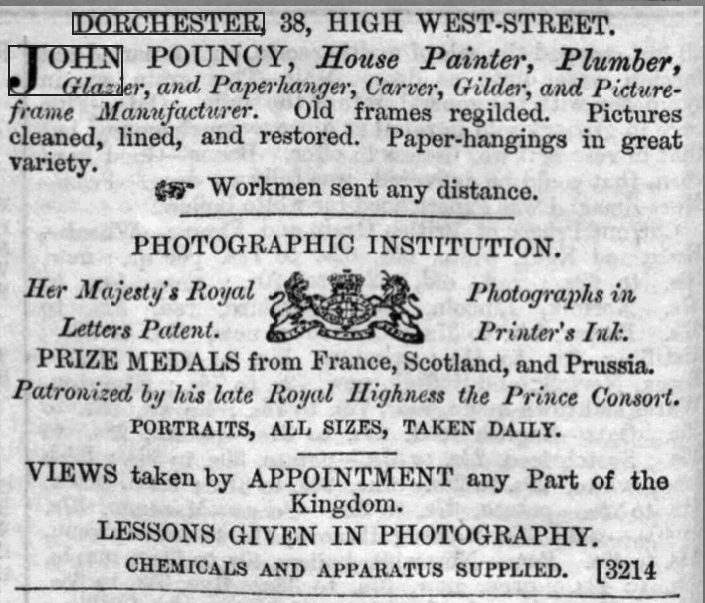
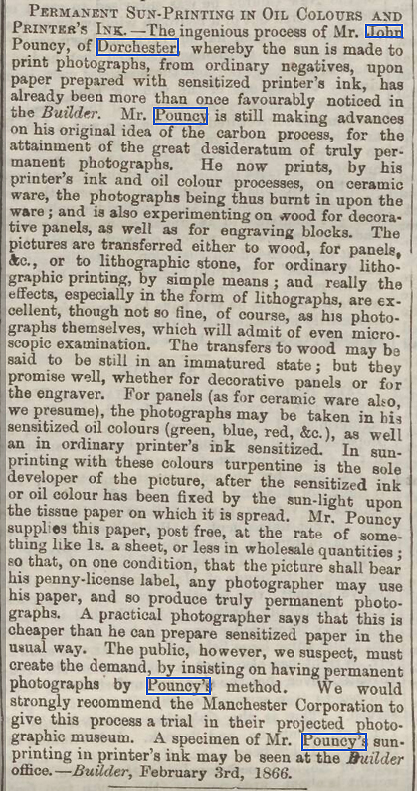
(Left) Advert appeared Dorset Chronicle 24 Jan 1867 - (Right) Report on Photographic Developments published in Western Flying Herald Tuyes Feb 6th 1866
He then continued to perfect the process over the next four or five years, and in 1863 he took out another patent, though acrimony was following not far behind as the question of who had truly been the inventor of carbon printing arose.
Pouncy did however receive some recognition for his pains from Thomas Sutton, editor of the journal “Photographic Notes,” and in 1859 he was finally awarded the French silver Duc de Luynes Medal. It is probable that John Pouncy did have a legitimate claim as the inventor of carbon printing, and he himself certainly thought so, even believing that he could rightly lay claim to the gold Duc de Luynes medal, awarded to a French rival, Alphonse Poitevin eight years later.
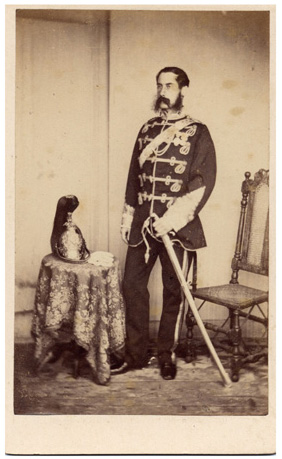
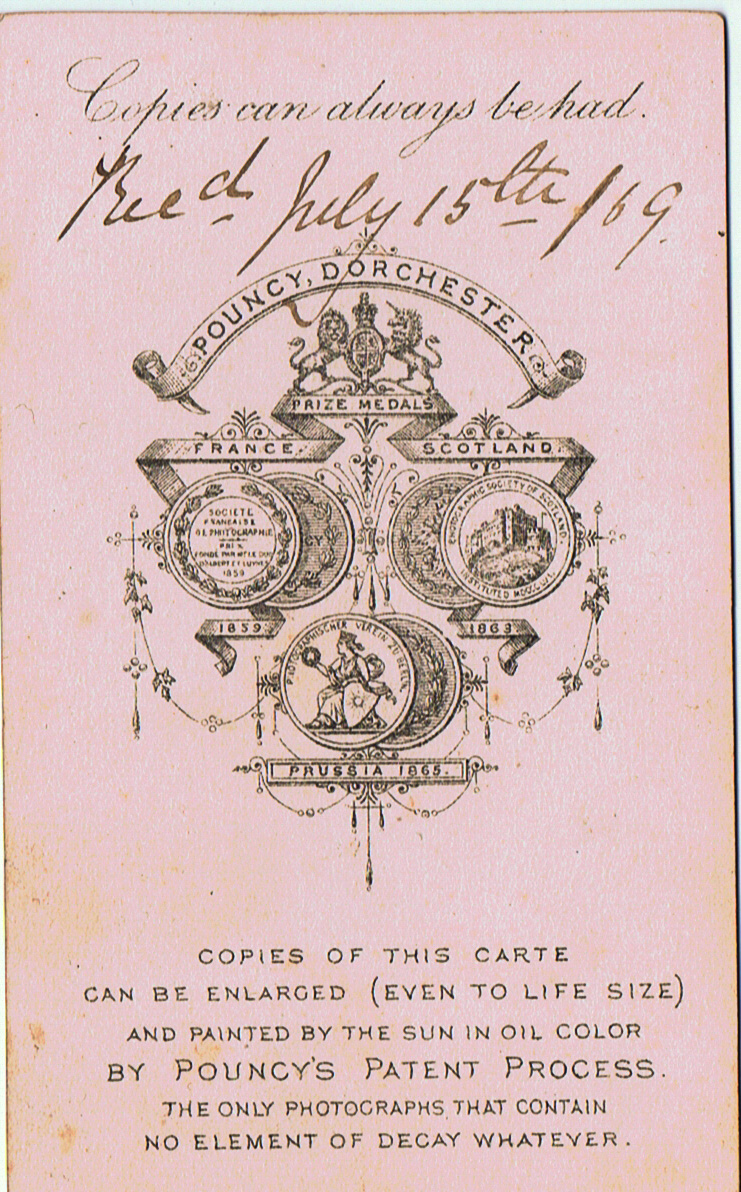

[Note:- The Picture left was taken by Pouncy in 1865. It shows Major Thomas BOTT of 6th Dragoon Guards standing in his full dress uniform. The 6th Dragoon guards were stationed at Dorchester Barracks a number of times.(12)
The picture right of a man who looks remarkably like Major Bott is dated 15th July 1859.]
Besides the Duc de Luynes prize Pouncy was awarded medals from Scotland (1863), Prussia (1865) and Edinburgh (1867) (12); furthermore his studio received patronage from the Prince Consort, Albert, and the Prince of Wales. It is widely suspected that a photograph of Thomas Hardy as a boy of 16 in the author’s archive was taken by Pouncy – not by any means the sole connection between the two men, as will presently be noted.
But the dispute over rival claims of inventor-ship and bickering within the profession that Pouncy experienced, diminished his ardour for the new art soon after the 1863 patent was granted. Throughout the 1860’s he was still ‘moonlighting’ as a decorator, but the premature deaths of his sons by his second wife left Pouncy with only Walter to inherit his photography business.(8) And in September 1872 the transition from father to son was done and dusted.
What Hardy did in writing to exteriorise Dorset, Pouncy did likewise in his photographs. And it is through this common life-mission that the two men’s paths inevitably converged. Consequently there exist several firm pieces of evidence that Hardy knew of Pouncy’s work and book, even if the latter had never taken that teenage portrait of the famous writer. These points can be summarised as follows:
(1) In Hardy’s novel “A Laodicean,” the central character William Dare is a photographic inventor seemingly modelled directly upon John Pouncy. In his carrying about of camera, tripod and equipment, Dare appears to be doing precisely what Pouncy would have done in preparing for his book on Dorset.
(2) When compiling Dorsetshire, Pouncy was in consultation with the architect John Hicks over matters of style and restoration. At exactly this time (July 1856) Hardy became apprenticed to Hicks for his architectural training.
(3) In 1881 Hardy was contemplating producing a book of his own on Dorset, very much along the lines of Pouncy’s, though in collaboration with Henry Moule.
(4) Even more compelling evidence that Dorsetshire was known to Hardy comes from the book itself. In its description of Kingston House, Pouncy explains how the brick building came to be faced in Portland stone: “…on one occasion before the notion had even entered the worthy owner’s head that Portland stone might be used advantageously to veil the brick walls of his mansion he was conversing with his illustrious visitor about the house.. The King [George III] however, did nothing but utter the words “Brick Mr Pitt, Brick…..” Hardy appears to be reproducing the same incident in almost identical wording in “The Hand of Ethelbert:” “…to a stone mask worn by a brick face a story naturally appertained…one which has since done service in other quarters. When the vast addition [i.e. the modern manor house]…had just been completed, King George visited Enchworth. The owner pointed out the features of his grand architectural attempt and waited for commendation. “Brick, brick, brick, said the King…Thin freestone slabs were affixed to the whole series of fronts by copper cramps and dowels.”
John Pouncy died in March 1894, aged 75(16) , after contracting a cold that developed into bronchitis. In its obituary the Dorset Chronicle & Somerset Gazette stated that he was a successful worker whose long study of his subject and its intricacies imparted much valuable information to the younger generation. Even in his last weeks of illness he was not content to stay indoors but would set out in the winter cold that probably hastened his untimely end.
Example of a John POUNCY Carte de Viste circa 1880
of two unknown men of the Pitfield Family
There are a number of problems with this card. The back of it refers to the prizes he won for photographic innovation the latest being Edinburgh in 1876 suggesting that the photograph on the front was taken after that date. His biography however states that the business at 38 High West Street had been handed over to his son Walter by 1872. I have no reason to doubt this statement as he was physically in Lancashire in 1871
and the Post Office Directory for 1875 confirms that Walter is in control of the business. When John returned to Dorchester he appears to have lived at 9 South Street with Walter continuing to trade from 38 High West street. It seems likely that Walter continued to trade under his fathers name because of his achievements in photography. Given the style of dress (bowler hats and double breasted waistcoats came into fashion from about 1855) this is an early photograph which I have guessed to be around the early 1880's.
.jpeg)
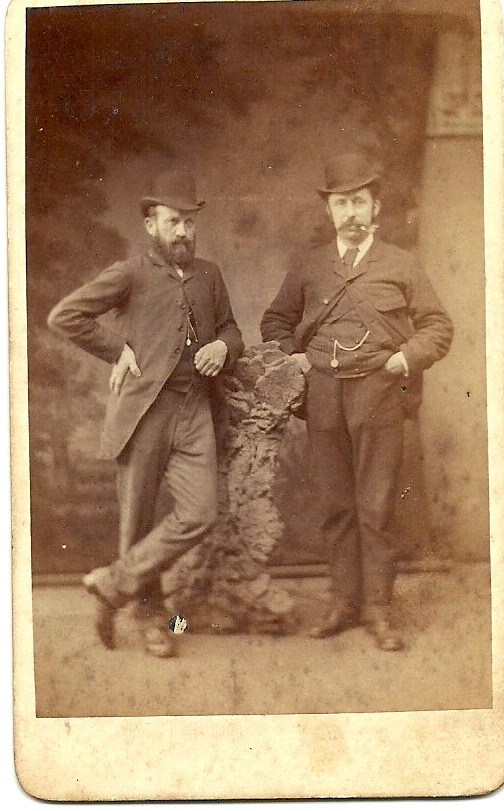
Pictures © Michael Pitfield 2013
By Walter Pouncy (1844 -1918)
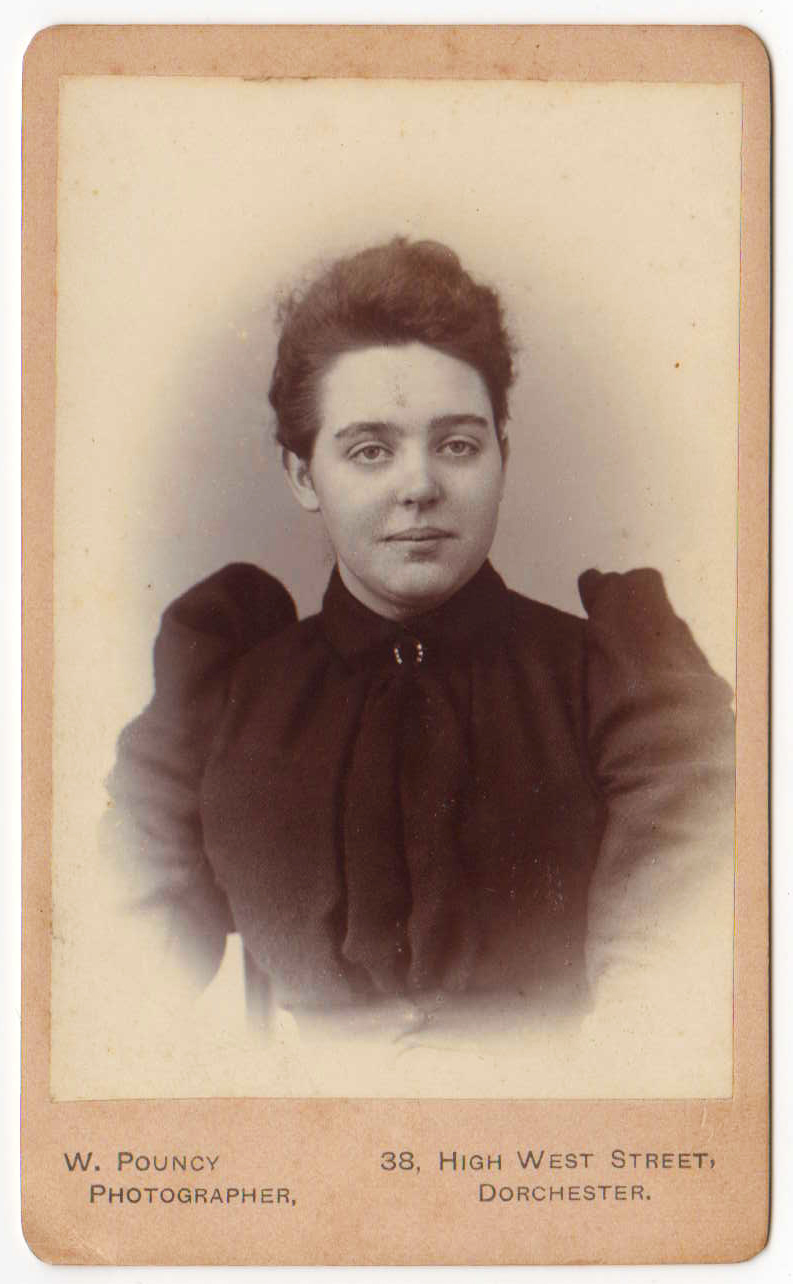
[The style of dress suggests taken in the 1890's
Walter Pouncy (1844-1918), John Pouncy’s only surviving son and business heir, was born in Fordington in 1845.(10) [Note:- The 1871 Census in fact shows him already running his fathers photographic business at 38 High West Street having taken over the employment of the three men who worked for his father. With him was his step sister Annie Pouncy (b.1854) who looked after the household while he concentrated upon the business. ] The 1891 census for Dorchester records that he married Eliza Rudduck (b.1850) (11) , a Reading woman, at Leeds in December 1881, and lists his occupation as that of “Photographic Artist.” By the time of the census Walter would have had full control of his father’s business (thereafter renamed W. Pouncy’s Photographic Institution) for 19 years.
Walter seems not to have possessed either his father’s inventiveness or his flair for controversy; he therefore did not cut a noticeable dash in Dorchester society. Nevertheless he maintained and built upon John’s archive of Dorset landscapes over another four decades and, perhaps like his father, personally knew and took studio portraits of Hardy.
Pouncy also made slides for illustrated lectures given by Harry Pouncy, a distant relative and namesake, on the subject of Wessex. When in 1914 the Dorset County Chronicle published a large landscape panorama of Maiden Castle taken by Walter (his chef d’oeuvre) it credited him with being simply “the doyen of Dorchester photographers.” A large collection of his pictures is in the possession of the County Museum. Walter Pouncy died in 1918, exactly a century after the birth of his father.
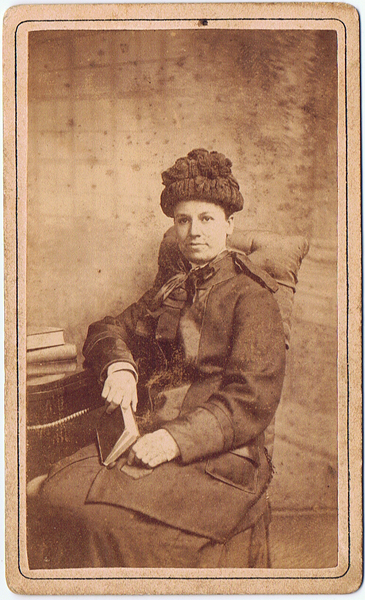
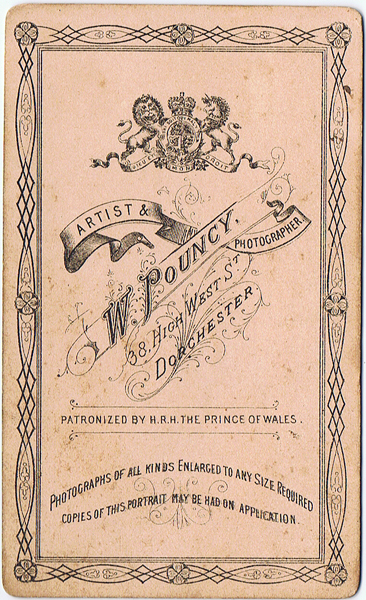
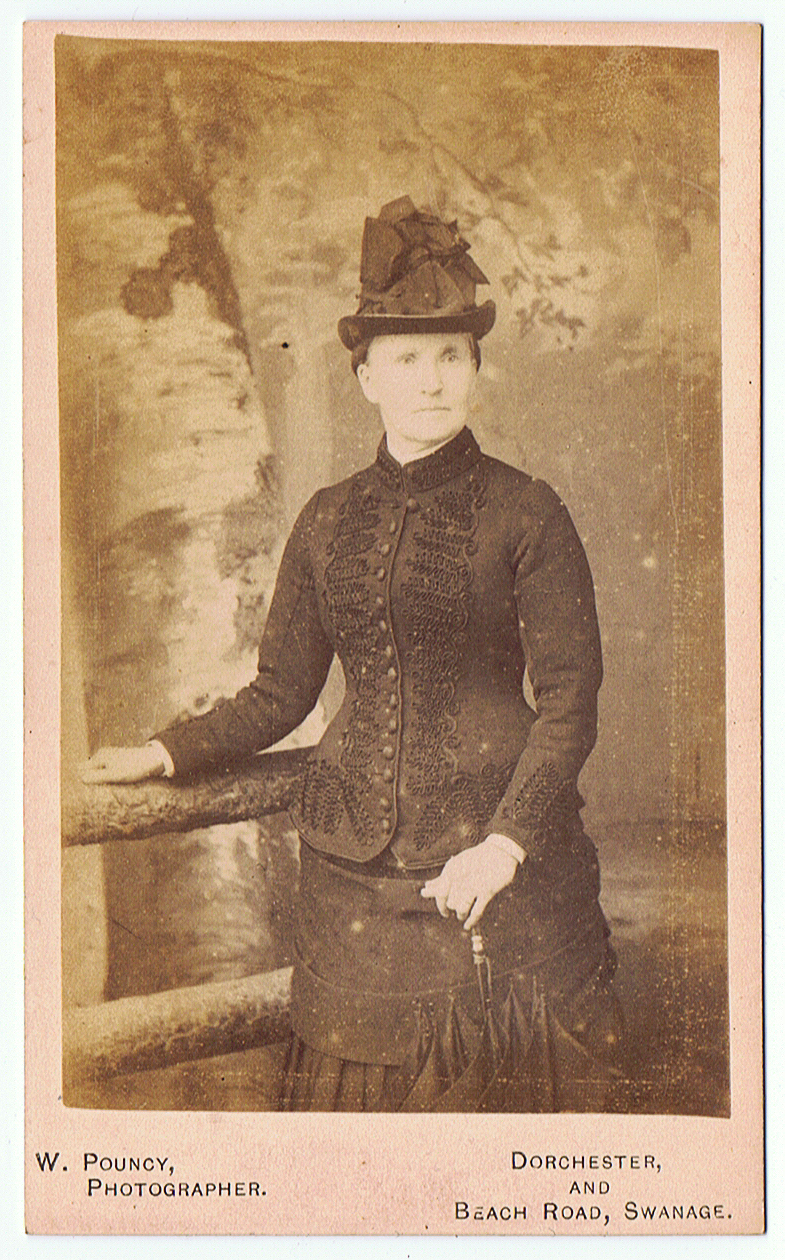
Two of Many Photographs taken by Walter Pouncy in his studio(9)
Pictures purchased by © Michael Russell OPC Dorchester 2011 & 2013
(If anyone knows who the ladies are please make contact)
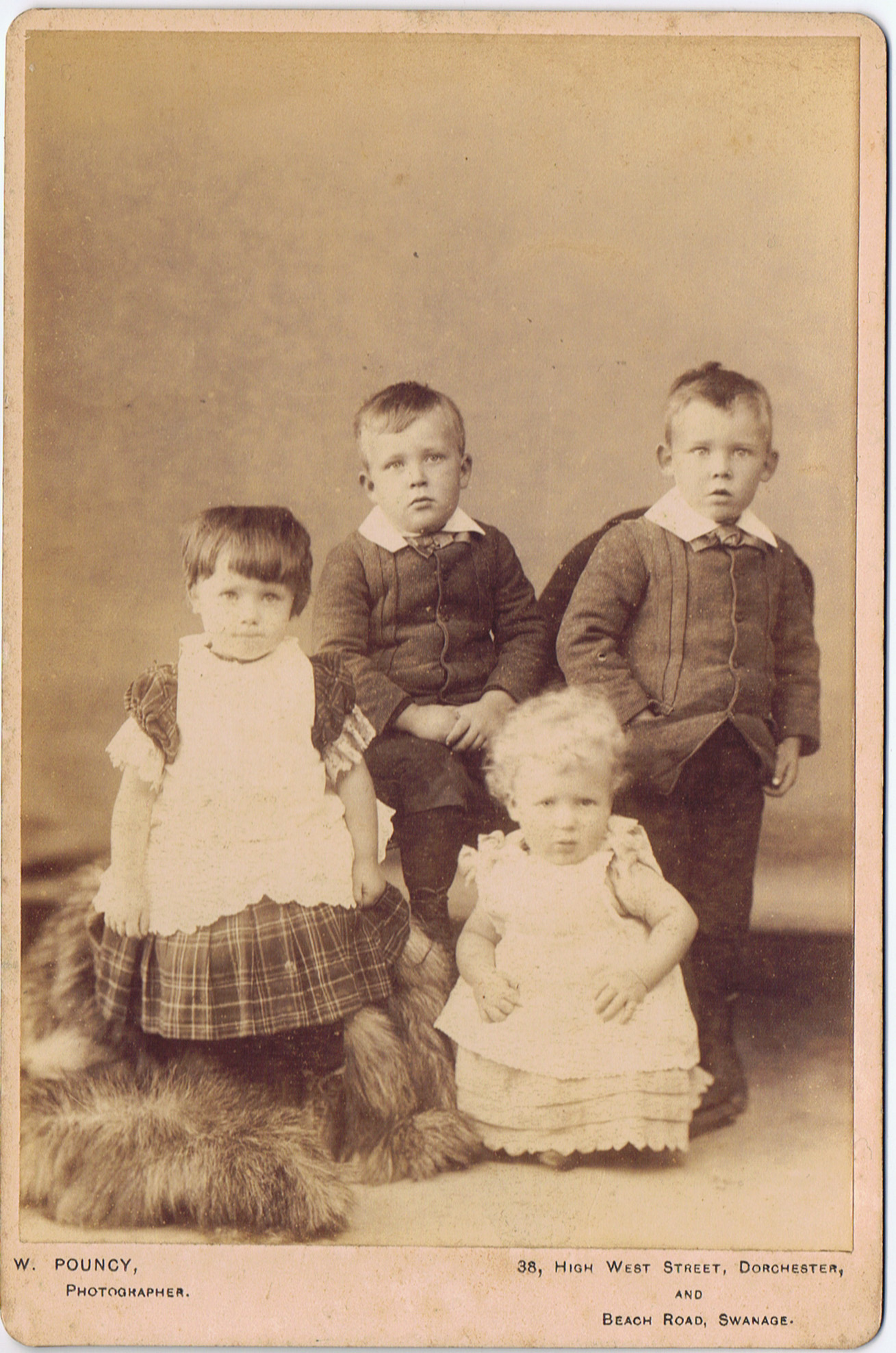
His father John Pouncy ran his business from 38 High West Street prior to 1861 and Walter took over circa 1872.
This picture of an unknown family is much later and has a blank back.
Genealogical Notes (Provided by Michael Russell OPC for Dorchester & Fordington):-
(1). This was the Cholera Outbreak of 1854 where he worked with the Rev Henry Moule (1801-1880).
(2). John Pouncy the son of William & Mary Pouncy an agricultural labourer was baptised at All Saints church in Piddletrenthide on 9th August 1818
(3). The marriage of John Pouncy to Mary Ann Sprankling is recorded at the GRO as Dorchester district 1843 3rd quarter Ref 8/103
(4). Walter Pouncy was baptised at St Georges Church Fordington by the Rev Henry Moule on 23rd June 1844 when John & Mary were living at Lester Buildings in Fordington
(5). Mary Ann Pouncy (nee Sprankling) was buried at St Georges Church Fordington on 18th Nov 1846 aged 28 years by the Rev Henry Moule by which time they had moved to live in the High Street in Dorchester.
(6). John Pouncy's marriage to Mary Catherine MILLS (not Wills as originally stated in the article) is recorded at the GRO in the year 1850 2nd quarter Dorchester district Ref 8/114
(7). Bishops Transcripts for baptisms for Holy Trinity church Dorchester are missing for the years 1852; 1854 to 1856 inc; 1858, and 1864 & 1865 - making identification of all their children difficult as I need the names to search for burials. I have however managed to compile the following which shows that only Kate and his son Alfred died young:-
(7a) Emily Catherine Pouncy was baptised at Holy Trinity church Dorchester on 25th January 1853; alive in all census returns to 1881 (she then appears to have married in the 1st quarter of 1888)
(7b) Annie Pouncy was baptised at HT Church on 7th Apr 1854 and is shown in the 1861 Census as aged 7 years and in the 1871 Census aged 17 with her elder step brother Walter living at High West St)
(7c) Kate Pouncy was baptised at HT Church on 17th June 1857. Her death is recorded at the GRO in 1860 2nd qtr Dorchester district Ref 5a/258 she was buried aged 3 at the civic cemetery on 27th April 1860
(7d) Alfred Caron (Corbin) Pouncy was baptised at Holy Trinity Church on 12th January 1859 but died the following January (GRO ref 5a/265) and was buried at the Civic Cemetery aged 1year on 14th Jan 1860
(7e) Jessie Mary Pouncy was baptised at HT Churc h on 30th Nov 1864 and is in the 1871 Census at Salford Lancs aged 7 and also 1881 Census as aged 17 in South St Dorchester (GRO born 1st qtr 1864 Dorchester district Ref 5a/317)
(8). John Pouncy in the 1871 Census is living at Seedley Hill in Salford Lancashire with his wife Mary Catherine and his two daughters, Emily & Jessie. He describes himself as an 'Inventor'. Walter is still at 38 High West Street in Dorchester running the Photrographic business with his sister Annie
(9). A picture he took of the Prince of Wales procession down High East street was engraved and published in the Graphic newspaper on 11th June 1887.
(10). Actually born the year before i.e. in the first half of 1844 see Genealogical note (4) above but could not locate birth at GRO.
(11). Walter Pouncy married Eliza Rudduck 1st Qtr 1881 Leeds reg district Ref 9b/841. They had a daughter Florence M. Pouncy who was unmarried aged 16 in the 1901 Census.
(12). The original of this picture is held at the Hampshire Museum their Reference HMCMS:FA2004.141.188 and is dated by them as being taken in 1865 where they name him as Major Bott of the 6th Dragoon Guards. Major Thomas BOTT of the 6th Dragoon Guards was elected as a member of the Army and Navy Club in 1855 and is listed as a member in their publication dated 1861.
(13). A copy of Dorsetshire Photographically Illustrated by john Pouncy published 1857 by Bland & long sold at Bonhams for £454 in 2004
(14). Census & Directory entries for John Pouncy
1841. John Pouncy age 20/24 Cuckholds Row Fordington, with his mother Mary and sister Eliza
1851. John Pouncy age 32 High West St painter guilder and glazier emp 3 men with wife Mary age 29
1852. Slators Directory - John Pouncy Painters, Plumbers and Glaziers High West Street?
1861. John Pouncy age 42 38 High West St painter & photographer emp 3 men with wife Mary age 39; Walter single age 16; Emily 8 and Annie 7
1865. Harrod's Directory - John Pouncy, painter, gilder, paper hanger, glazier, photographer, and inventor and patentee of carbon, 38, High East street
1871. John Pouncy age 53 Seedley Hill Lancashire an inventor with wife Mary age 49, Emily age 18 and Jessie age 6
1875. PO Directory Walter Pouncy Whittington Insurance Agent 38 High West street. POUNCY, Walter; photographic artist, painter, glaszier, picture frame maker Etc, 38 High West street
1881. John Pouncy age 62 13 South St House decorator, with wife Mary Kate age 60, Emily single age 20, Jessie single age 17
1889. Kelly's Directory POUNCY; John; 9; South Street; Inventer & patentee of photographs in oil colours, Painter & dec.; - also POUNCY; Walter; 38; High West Street; Photographic artist, painter, guilder,picture restorer/framer;
1891. John Pouncy age 72 - 9 South St House decorator, with wife Mary C age 69, Anne age 35, Jessie age 25 - Walter Pouncy 38 High West St Head Married age 46 Photographic Artist + Eliza Pouncy wife married age 421 + Florence M. Pouncy daughter aged 6 years
1894. John Pouncy died
1895. Advertisement Weymouth Telegram 1 Oct 1895 - Artistic Photography -- WALTER POUNCY --- 38 High West Street, and ( South Street Dorchester and Beach Road Swanage Price List on Application. Sittings by Appointment preferred
1901. Walter Pouncy 38 High West Street, married, age 56, Photographer, employer at home, born Dorchester with Eliza Pouncy wife married age 52 born Reading Berkshire; Florence Pouncy daughter single age 16 born Dorchester
1911. Walter Pouncy 38 High West Street, Head aged 66 years married for 30 years with 1 child still living. Photographer with wife Eli8za age 60
(15). As can be seen from the image provided the prize he was awarded in 1867 was 'Paris'; 'Edinburgh' being 1876
(16). John Pouncy's death Registered at the GRO 1st qtr 1894 aged 75 years Ref 5a/257
|
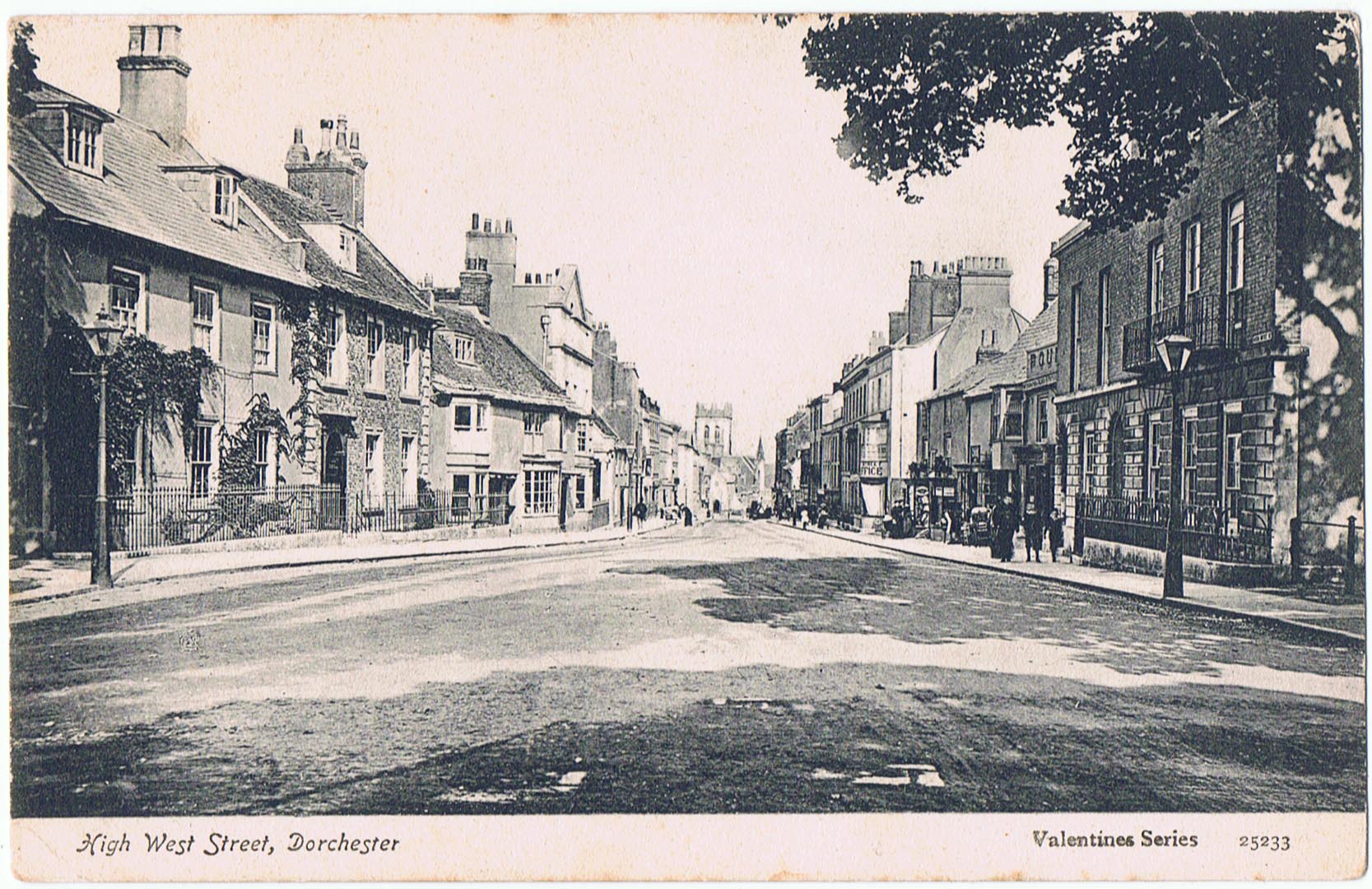








.jpeg)





